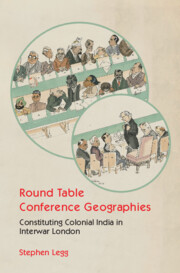Book contents
- Frontmatter
- Contents
- List of Figures and Tables
- Acknowledgements
- Note on Conversions, Spellings and Abbreviations
- 1 Introduction: Squaring Round Tables
- Part I Geographical Imaginations
- Part II Conference Infrastructures
- Part III The Conference City
- Part IV Representations
- Notes
- References
- Index
- Miscellaneous Endmatter
6 - The Speech Factory: Palace Materials and Communication Technologies
Published online by Cambridge University Press: 15 January 2023
- Frontmatter
- Contents
- List of Figures and Tables
- Acknowledgements
- Note on Conversions, Spellings and Abbreviations
- 1 Introduction: Squaring Round Tables
- Part I Geographical Imaginations
- Part II Conference Infrastructures
- Part III The Conference City
- Part IV Representations
- Notes
- References
- Index
- Miscellaneous Endmatter
Summary
Having gotten to Britain, the delegates, advisors and secretaries set to their conference work. The following chapters will make it clear how much the conference depended upon the spaces and capabilities of London as a national and imperial capital. This chapter will focus on the conference’s direct infrastructure. It opens by considering the formal heart of the conference, St James’s Palace. Rather than take this site for granted, it will be shown to have been a composite of buildings, material infrastructures and objects (tables, but also toilets). As a working space it will be explored as an assemblage of architecture, furniture and office stationery but also of texts that thoroughly connected the palace to London and to the world. The relational construction of the conference palace was further enhanced by the role of communication infrastructures which turned it into a global site of imperial projection via the press, photography, telegrams, radio broadcasts and filming for national and global cinema screens. As such, while one form of conference mobility involved getting people to London and getting their messages out to the world, another facilitated the movement of people, objects and representations into, around and out of a Tudor palace in the district of St James’s (Figure 6.1).
THE PALACE
St James’s Palace was constructed in the 1530s for Henry VIII and figured in pivotal moments in British royal history (K. Scott 2010). In 1558 Mary Tudor signed the treaty there that surrendered Calais to the French; in 1588 Elizabeth I set out from St James’s to address her troops at Tilbury in the face of the Spanish Armada; while every monarch used it as a residence between the Palace of Whitehall fire of 1698 and Queen Victoria’s formal move to Buckingham Palace in 1837. From this time on, St James’s was used as an official residence for some royals, including the Prince of Wales. But it was also an increasingly open royal palace, being used for ceremonials and public audiences and having rooms made available for the meetings of charitable organisations in the twentieth century. In 1912 it hosted its first conference, which was organised by the Foreign Office concerning the end of conflict between the Ottoman Empire and a coalition of Balkan States (K. Scott 2010).
- Type
- Chapter
- Information
- Round Table Conference GeographiesConstituting Colonial India in Interwar London, pp. 159 - 190Publisher: Cambridge University PressPrint publication year: 2023



